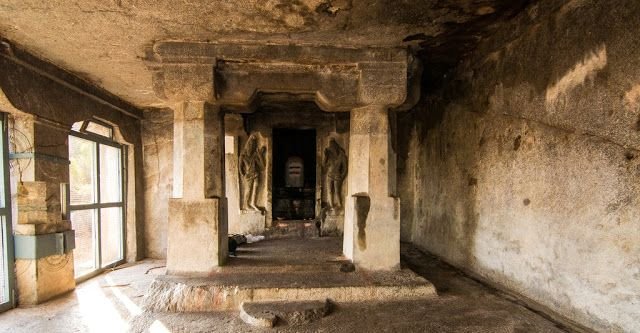Mandagapattu Tirumurti: The First Stone-Cut Temple of South India

The Mandagapattu Tirumurti Temple, located in the Viluppuram district of Tamil Nadu, is an ancient Hindu temple created from solid rock. This temple, attributed to the Pallava ruler Mahendravarman I, represents a significant development in early Dravidian temple architecture. Mahendravarman I, who ruled during the 7th century, was a pioneer of rock-cut architecture, and the Mandagapattu Tirumurti Temple is one of his most remarkable contributions. Unlike temples that used traditional building materials, this structure was hewn directly from the rock, without any bricks, mortar, timber, or metal—an approach Mahendravarman I proudly highlighted in inscriptions.

The temple’s design set an important example in Tamil Nadu, making it one of the earliest known rock-cut shrines for Hindu deities. Before this, temples were typically built using wood or other perishable materials, but Mahendravarman I’s vision was to create a structure that would stand the test of time, in honour of the Hindu Trinity. The Mandagapattu Tirumurti Temple holds the distinction of being the oldest stone shrine to Hindu gods in Tamil Nadu, a testament to the Pallavas’ innovative approach to architecture.

HISTORY:
The Mandagapattu Tirumurti Temple is significant not only for its architectural innovation but also for the inscriptions it houses. One of the earliest known rock-cut inscriptions in the Grantha script can be found here. This script was used for writing Sanskrit and, at that time, was widely used in southern India. Mahendravarman I’s inscription in this temple conveys his pride in achieving the construction of a rock-cut temple without traditional materials, underscoring his ambition to establish a lasting legacy through stone architecture.

The temple was dedicated to the Hindu Trinity—Brahma, Vishnu, and Shiva, the gods associated with creation, preservation, and destruction, respectively. This choice reflects Mahendravarman I’s devotion and the importance of these deities in the religious life of that period. The Pallava dynasty, of which Mahendravarman I was an influential ruler, is credited with initiating the practice of constructing shrines dedicated to multiple Hindu gods within a single space, an idea that later became more widespread across South India.
DEITY:
In Mandagapattu Tirumurti Temple, the Hindu Trinity Trimurti refers to (Brahma, Vishnu, and Shiva )is worshipped together, highlighting the Pallavas’ respect for these primary deities. The Trimurti concept represents the cosmic cycle: Brahma as the creator, Vishnu as the preserver, and Shiva as the destroyer. By bringing these three gods together in one temple, Mahendravarman I not only emphasized their individual importance but also symbolized the balance they bring to the universe. This temple remains one of the few that honor all three gods in a single sanctum, demonstrating the ruler’s progressive thinking and his desire to convey harmony among the divine powers.

ARCHITECTURE:
The Mandagapattu Tirumurti Temple is modest in its size and decoration, particularly when compared to the grand temples that were constructed later. However, its simplicity is central to its appeal. The temple is primarily a small rock-cut cave that is striking in its austerity and innovation. The shrine itself is a small chamber, hewn from the rock, with pillars and basic decorations carved directly into the stone. This straightforward design is not overly adorned, focusing on durability and the spiritual significance of the temple rather than intricate details.

The temple does not have the towering vimana (tower) typical of later South Indian temples. Instead, its value lies in its function as an early example of a stone temple, representing the evolution from temporary structures to more permanent forms of worship. Mandagapattu Tirumurti Temple set the stage for later architectural advancements, where more elaborate features and designs would eventually emerge in South Indian temple construction.
CONCLUSION:
The Mandagapattu Tirumurti Temple is a remarkable early example of rock-cut architecture in South India and a testament to the vision of Mahendravarman I and the Pallava dynasty. As one of the first temples to be hewn from solid rock, it reflects a major shift in temple construction, moving away from perishable materials and toward stone structures that would endure over centuries. The dedication of this temple to the Hindu Trinity, Brahma, Vishnu, and Shiva, underlines the Pallavas’ deep religious convictions and their effort to create a lasting spiritual legacy.

Today, the Mandagapattu Tirumurti Temple stands as a symbol of Tamil Nadu’s rich architectural history and the innovation that characterized the Pallava period. This small yet historically significant temple paved the way for the grander rock-cut temples that followed and remains a cherished landmark in the evolution of South Indian temple architecture.


